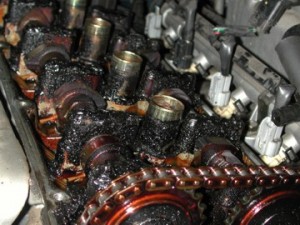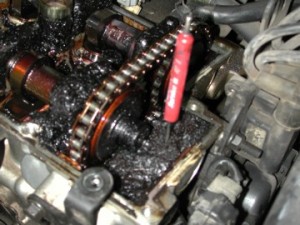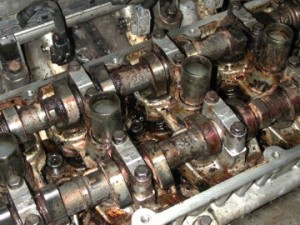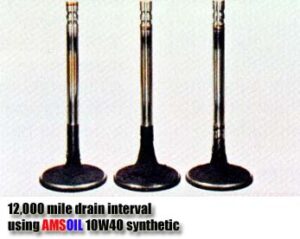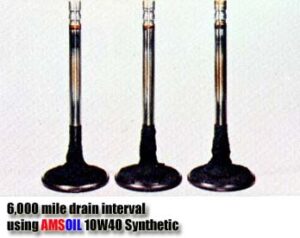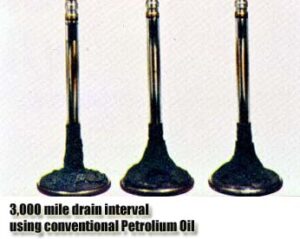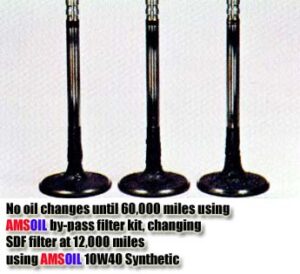 Ever wondered what would happen if you just stopped changing your oil? Everyone knows the “every 3000 miles” stuff is just propaganda so your local repair shop can keep you coming back more often, so why be one of the sheeple? Why not quit, and stop being used by The Man? This month we answer that question using a real-life example from one of our clients, but be warned… there are pictures!
Ever wondered what would happen if you just stopped changing your oil? Everyone knows the “every 3000 miles” stuff is just propaganda so your local repair shop can keep you coming back more often, so why be one of the sheeple? Why not quit, and stop being used by The Man? This month we answer that question using a real-life example from one of our clients, but be warned… there are pictures!
Clean oil is essential to the operation of your vehicle. Oil works by building a slippery film around all the moving parts of your engine to reduce friction during operation. Dirty oil carries abrasive particulates through your motor, grinding against the parts like sandpaper and causing needless engine wear. Even dirty oil is better than no oil at all, because without oil the parts themselves contact and can cause catastrophic engine failure in seconds. When engine oil remains in service beyond its recommended lifetime (about 3000-5000 miles for conventional oil, and about 6000-8000 miles for synthetic), it begins to burn off and leave hard sludgy deposits similar to the burnt mess found on the bottom of a neglected oven. The best solution to this problem is to change your engine oil regularly.
A new client (we’ll call him/her “Mr. X”) brought their vehicle in with a check-engine light, power loss, rough idle, and a severe oil leak. The vehicle had been running fine until all of a sudden the problems hit. We put the car on the rack and quickly diagnosed a leak in the valve cover gasket (the gasket that makes a complete seal between the engine block and the metal cover on top of it.) A little investigation showed that Mr. X was overdue for an oil change… 20,000 miles overdue! Luckily, Mr. X brought the car in before more major damage was done. We were able to clean the sludge off of the internal components, but not before we took the horrific pictures below.
The most important lesson from Mr. X’s experience is the ABSOLUTELY CRITICAL IMPORTANCE OF OIL CHANGES. Another lesson is that Mr. X had been driving happily with no problems until the sudden gasket failure. This is common in modern vehicles, where computer systems can mask problems until you’re left on the side of the road. Don’t assume that if your vehicle is showing no problems then there’s nothing wrong! A final lesson is that this problem was Mr. X’s first experience with Tom Dwyer Automotive. Had he been a regular client already, our proactive maintenance and inspection programs would have caught the fact that he was behind on his oil changes long before problems actually appeared. This is exactly the type of problem we work so hard to avoid, and now that Mr. X is planning to come back to us he can drive confidently knowing that we’ll be watching out for him.
Now, as we promised, here are the graphic and horrifying pictures of what can happen to your engine if you don’t stay up on oil changes. Again, beware… these pictures are NOT FOR THE FAINT OF HEART!
Before- Over the miles, the engine oil had broken down into its basic parts and formed a tar-like black sludge that coated the entire engine. These pictures show the top of the engine with the valve cover removed. The sludge had packed the engine such that the engine parts and oil had to fight through the goo in order to move. The second picture shows just how thick that goo was… that screwdriver is stuck into the sludge about 1½ inches.
After- It took a while, but we were finally able to clean everything out. Now you can see the moving parts that were covered by the burnt oil. The second picture shows that same chamber that had the screwdriver stuck into it, now clean as a whistle. Once again, this is an engine that’s ready to run cleanly and efficiently.
If you want to avoid Mr. X’s horrifying experience, just change your oil. We generally recommend changes every 4000 miles for regular oil, every 6000 miles for synthetic. And we recommend switching to synthetic oil if you haven’t already because it’s better for you, your vehicle, and even the planet.
How To Cut Your Oil Changes In Half- Synthetic Oil Protects Better and Lasts Longer (November,2010)
Synthetic oil is slowly replacing non-synthetic throughout the automotive industry. Many manufacturers are requiring synthetic oil only in new vehicles, and most new vehicles at least use a synthetic blend. However, the only thing most people know about synthetic oil is that it costs more than conventional. There’s much more to the story, which is why we’re recommending that all our clients consider the benefits of using synthetic oil when they do their Minor Interval Services with us. This month, we thought we’d give you the nitty gritty on the lifeblood of your vehicle…
What’s the difference between “conventional” and “synthetic” oils?
Conventional motor oil is a combination of processed crude oil (base stock) with various chemical additives to increase performance. Because the base stock is simply a refined natural product, it has much of the variability of natural products- the hydrocarbon chains vary wildly in size, and it has many impurities that can’t be removed by the distillation process.
Synthetic oils aren’t synthetic or artificial in the sense that they’re manufactured from scratch- they still have the same natural ingredients found in “real” oil. Typically, the best synthetic oils use a combination of up to three different synthetic base fluids– polyalphaolefin (PAO), synthetic esters, and alkylated aromatics. But in a synthetic lubricant these ingredients are recombined into hydrocarbon chains with very uniform molecule sizes and very few impurities. This uniformity gives a wide range of superior characteristics.
Synthetic Pros
Synthetic motor increases the life of your engine
You can go longer between oil changes; usually double the mileage or more
Better for extreme driving conditions, especially extremes in temperature
Better mileage from reduced engine friction and lower operating temperature
Quicker coating of engine parts on startup
Less oil consumption
Lowered octane requirements
Synthetics decrease dependence on natural oil
Synthetics leave fewer deposits, and so cause less emissions
Synthetic Cons
Synthetic motor can cost up two or three times more than conventional motor oil
Better lubrication
Both synthetic and conventional motor oils form a layer of molecules over your engine’s inner surfaces. This film prevents the metal itself from touching, providing lubrication and ease of motion. “Film strength” is the amount of pressure needed to force out a film of oil from between two pieces of flat metal. The higher the film strength, the greater the lubrication. Synthetics normally have a film strength of over 3,000 psi, while petroleum oils average a little less than 500 psi. This greater lubrication leads to big advantages for engines, especially for modern engines with their tighter tolerances, higher operating temperatures, and smaller oil passages. The more easily an engine turns the more energy available for useful work and the longer the parts will last.
Under hood temperatures also factor into the life of any lubricant, especially with the use of power options like air conditioning, and with emissions devices and emissions-related design. Even though your dash gauge may show a water/coolant temperature of 200 degrees, the temperature internal engine components can be higher than 500 degrees. These high-temperature surfaces rapidly decompose petroleum oil and additives while the synthetic is mostly unaffected.
Temperature
Although it’s not much of an issue here in Portland, synthetic oils function in wider range of temperatures than conventional oils. People in very cold climates normally use thinner conventional oil for the winters, which stays liquid in much colder temperatures. Although the oil continues to pour, because it’s thinner it doesn’t do as good a job of protecting the engine when it reaches normal operating temperatures.
Synthetics stay fluid in cold weather because they don’t have the waxy contaminants of conventionals, but they still have the lubricating properties. Mobil produces a 5W-30 oil that will still pump at -58 degrees, while conventional 5W-30 oil freezes up around -35 degrees. Their 0W-30 oil has no conventional equivalent, and continues to flow at -62 degrees and below.
Emissions
The variable size of molecules in conventional oils mean that as the temperature of the oil increases, the smaller molecules are stripped away from the oil and are available to form sludge and gunk in your engine. Crude oil also has thousands of varieties of contaminants which no amount of refining can entirely remove. Corrosive acids, paraffins and other waxes, heavy metals, asphalt, napthenes and benzenes, as well as countless compounds of sulfur, chlorine, and nitrogen are available to gum up the system. This soup can also migrate to your catalytic converter, where it can reduce the efficiency of the converter or be burned off as pollution itself.
Synthetic Oil testing
To give you an idea about how synthetics and conventionals perform in the real world, here’s what happened in a demonstration project using a fleet of New York taxis.
The demonstration spanned 60,000 odometer miles of New York taxi service on each car, but with the amount of time the taxis spend idling the total number of “engine miles” was about twice the odometer miles.
A group of conventional-oil taxis whose oil and filter was changed every 3,000 miles was compared against three groups of synthetic-lubricated taxis. The first group had their oil and filter changes at 6,000 miles, the second group at 12,000 miles, and the third would not change the oil for the full 60,000 of the test, but this group also used a special oil filter which would be changed at 12,500 mile intervals.
After the year-long demonstration, each of the engines was disassembled to determine the levels of sludge, varnish and rust inside the engine, and to carefully measure the amounts of wear on engine components.
The short story? The synthetic oil provided protection of the test engines far beyond the normal 3,000-mile oil change interval. In fact, the engines run with synthetic oil for the full 60,000 mile showed less wear than did the group that had oil changes every 3000 miles.
Another example of synthetic oil performance comes from the world of racing. Race-car driver Bobby Unser said “I’ve had tremendous success with synthetics; both grease and oil, in all my cars. In several instances where we have compared petroleum-lubricated engines with those which used synthetics, the latter were cleaner, with less carbon and sludge. And the engines produced more horsepower, which meant better mileage and longer life.”
Conclusion
According to Amsoil (a synthetic oil manufacturer), “…synthetic lubricant technology is swiftly progressing to a point where it is possible that engine wear may no longer continue to be the major limiting factor in the expected life span of motor vehicles.” So if synthetics are so good, why aren’t even more people using them? One reason is that most people don’t know about synthetics at all, a situation we’re trying to remedy with this article. Others who do know about them (even many professional mechanics) haven’t kept up with the new lubricant technology and still worry about the problems with the early products. But perhaps the main reason is that many people are put off by the higher cost of the oil itself and don’t weigh the cost against the advantages. Yes, the oil costs about twice as much, but that extra money pays for fewer oil changes, better vehicle performance, longer vehicle life, better emissions, and (slightly) reduced dependence on foreign oil. We think it’s well worth the extra cost, and we hope you consider using synthetic oil the next time you come in for our Minor Interval Service.

